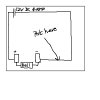eduardo_uk
New Member
Ive been trying to work out a way of varying the speed of a tank circuit (a bell) want it to work from 5-12V (have a power supply that can vary voltage but cant be tuned whist the unit is running) have tried it using a potentiometer 4.7k and a 22k one, each time it seems to work fine but then when the wire in the potentiometer is at it's shortest it heats up and glows white hot. Cant seem to get hold of a rheostat that will do it any ideas as to how i can sort this problem out.

